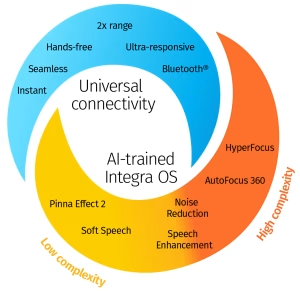

In the realm of accessibility and inclusivity, the Americans with Disabilities Act (ADA) plays a crucial role in ensuring equal opportunities for individuals with various disabilities. When it comes to auditory accessibility, hearing aids and related accessories become vital tools. One effective means of meeting ADA requirements seamlessly is through the integration of T-coils and the utilization of hearing loops. If you don’t know what a hearing loop is, here is a blog about loops.
T-coils, also known as telecoils or induction coils, are small but powerful components embedded in many modern hearing aids. These coils enable a direct connection to hearing loop systems, contributing significantly to the accessibility of public spaces. This connection enhances the auditory experience for individuals with hearing impairments. Aligning with the ADA’s objective of creating an inclusive environment for all.
In this context, we’ll explore the role of T-coils and hearing loops as a practical solution for meeting ADA standards. Ensuring that individuals with hearing disabilities can fully participate in various public spaces and enjoy equitable access to auditory information.
A T-coil is a small, coil-shaped piece of wire that is often integrated into hearing aids. The primary function of a T-coil is to enhance the hearing aid user’s ability to hear better in situations where there may be interference from background noise. Or where audio signals need to be transmitted directly to the hearing aid without picking up ambient sounds.
The T-coil works by picking up electromagnetic signals. Such as those generated by telephones, public address systems, and induction loop systems. These systems create a magnetic field that the T-coil in the hearing aid can detect. By using the T-coil, the hearing aid wearer can switch to a mode that focuses on the electromagnetic signals while minimizing background noise.
One common application of T-coils is in venues equipped with induction loop systems. Induction loops are essentially wire loops installed in specific areas, like theaters, auditoriums, or churches. These loops transmit sound directly to T-coil-enabled hearing aids. When a hearing aid user activates the T-coil mode, they can receive a clearer and more direct audio signal from the induction loop. Improving their listening experience in environments with challenging acoustics.
T-coils contribute to the accessibility and inclusivity of hearing aid technology by providing users with improved communication capabilities in various settings.
1. Design constraints: Some smaller or more discreet hearing aid models may have limited space for additional components. In such cases, manufacturers may prioritize other features or technologies over T-coils to meet size and design requirements.
2. Cost considerations: T-coils, although valuable for improving accessibility, can add to the manufacturing cost of hearing aids. In some cases, manufacturers may opt to produce more budget-friendly hearing aids without T-coils. Allowing them to make them more affordable for a broader range of users.
3. User preferences: Not all hearing aid users may require or prefer T-coils. Those who primarily use their hearing aids in quiet environments or do not frequently encounter situations with electromagnetic signals may not find T-coils as essential. In such cases, manufacturers may focus on other features that cater to the specific needs of their target audience.
4. Advancements in technology: Some hearing aids may utilize alternative technologies or features that provide similar benefits to T-coils. For example, advancements in digital signal processing and directional microphone technology can help improve speech understanding and reduce background noise without the need for a T-coil.
5. Market demand: Manufacturers often design hearing aids based on market demands and trends. If there is less demand for T-coils due to changing preferences or advancements in other technologies, some hearing aids may omit this feature.
It’s essential for individuals seeking hearing aids to communicate their specific needs and preferences to their audiologist or hearing healthcare professional. The choice of hearing aid features, including the presence or absence of a T-coil, should align with the user’s lifestyle, communication requirements, and hearing preferences.
Do not underestimate the T-coil – it stands as an impressive, time-tested technology designed to enhance your hearing experience in various venues. Ensure to inquire with your hearing care provider about the inclusion of a T-coil in the prescribed hearing aid. At Hears to U, Hearing & Hearables, we are staunch advocates of the T-coil and hearing loop. Extending our recommendation to individuals with even mild hearing loss. Choosing an aid with a T-coil, even if slightly larger, becomes crucial when attending venues equipped with a hearing loop – you might regret not opting for this feature.
Signia Pure Charge&Go BCT IX hearing aids provide seamless Bluetooth Classic connectivity, superior sound processing, and all-day battery life. Designed for comfort and performance, these small, rechargeable RIC hearing aids offer hands-free calls, music streaming, and advanced speech clarity. Key features include:
Powered By SinglerDesign.com